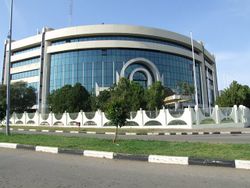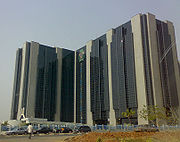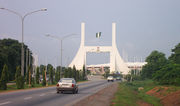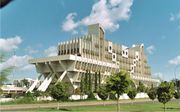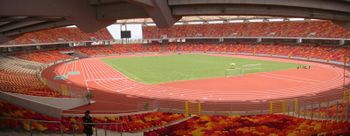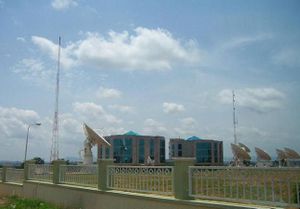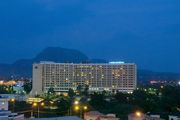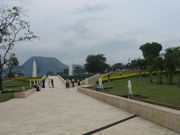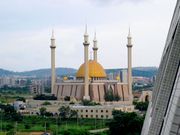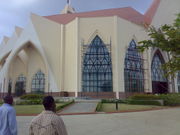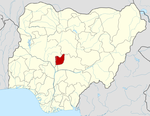Abuja
| Abuja | |
|---|---|
| — City — | |
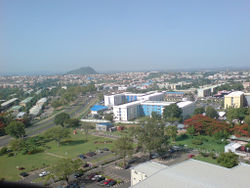 |
|
 Abuja
|
|
| Coordinates: | |
| Country | |
| Territory | Federal Capital Territory (Nigeria) |
| Government | |
| - Minister | Bala Mohammed |
| Area | |
| - Total | 713 km2 (275.3 sq mi) |
| - Land | 713 km2 (275.3 sq mi) |
| Population (2006) | |
| - Total | 778,567 |
| - Density | 1,092/km2 (2,828.2/sq mi) |
| [1] | |
| Time zone | WAT (UTC+1) |
| Website | fct.gov.ng/fcta |
Abuja is the capital city of the West African nation of Nigeria. It is located in the center of Nigeria in the Federal Capital Territory (FCT). Abuja is a planned city[2], and was built mainly in the 1980s. It officially became Nigeria's capital on 12 December 1991, replacing Lagos, the previous capital. As of the 2006 census, the Federal Capital Territory has a population of 778,567.
Contents |
History
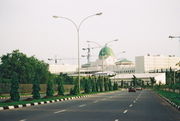
In light of the ethnic and religious divisions of Nigeria, plans had been devised since Nigeria's independence to have its capital in a location deemed neutral to all parties. The location was eventually designated in the centre of the country in the early 1970s as it signified neutrality and national unity. Another impetus for Abuja came because of Lagos' population boom that made that city overcrowded and conditions squalid. The logic used was similar to how Brazil planned its capital Brasília. Construction broke ground and was dedicated in the late 1970s, but due to economic and political instability, the initial stages of the city were not complete until the late 1980s.
The master plan for Abuja and the Federal Capital Territory (FCT) was developed by International Planning Associates (IPA), a consortium made up of three American firms: Planning Research Corporation; Wallace, McHarg, Roberts and Todd; and Archisystems, a division of the Hughes Organization. The master plan for Abuja defined the general structure and major design elements of the city that are visible in the city's current form. More detailed design of the central areas of the capital, particularly its monumental core, was accomplished by Kenzo Tange, a renowned Japanese architect, along with his team of city planners at Kenzo Tange and Urtec company.
Most countries relocated their embassies to Abuja, and many maintain their former embassies as consulates in Lagos, still the commercial capital of Nigeria.
Abuja is the headquarters of the Economic Community of West African States, or ECOWAS. It also has the regional headquarters of OPEC.
Abuja and the FCT have experienced huge population growth; it has been reported that some areas around Abuja have been growing at 20 to 30% per year.[3] Squatter settlements and towns have spread rapidly in and outside the city limits.[2][4] Tens of thousands of people have been evicted since former FCT Minister Nasir Ahmad el-Rufai started a demolition campaign in 2003.[5]
The Phase 1 area of the city is divided into five (5) districts. They are the Central, the Garki, Wuse, Maitama, and Asokoro. There are also five districts in Phase 2. They are Kado, Durumi, Gudu, Utako and Jabi. And the Phase 3 districts are Mabuchi, Katampe, Wuye and Gwarimpa. There are also five suburban districts, which are Nyanya, Karu, Gwagwalada, Kubwa, and Jukwoyi. Along the Airport Road are clusters of satellite settlements, namely Lugbe, Chika, Kuchigworo and Pyakassa. Other satellite settlements are Idu (the main industrial zone), Mpape, Karimu, Gwagwa, Dei-Dei (housing the International Livestock market and also International Building materials market).
Abuja International Airport
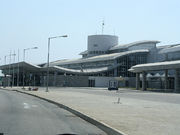
Nnamdi Azikiwe International Airport is the main airport serving Abuja and the surrounding capital region. It was named after Nigeria's first President, Dr. Nnamdi Azikiwe. The airport has both international and domestic terminals.
The federal capital territory's ministers since the relocation of the federal capital to Abuja are as follows: John Jatau Kadiya, 1979–1982; Iro Abubakar Dan Musa 1982 - 1983; Haliru Dantoro 1983 - 1984; Mamman Jiya Vatsa 1984 - December 1985; Hamza Abdullahi 1986 - 1989; Gado Nasko 1989 - 1993; Jeremiah Timbut Useni 1993–1998; Mamman Kontagora 1998 - 1999; Ibrahim Bonu 1999 - 2001; Mohammed Abba Gana 2001 - 2003; Nasir Ahmad el-Rufai 2003 - May 2007; Aliyu Modibo 2007 - 2008; Adamu Aliero 2008 - the present
Districts
Central District
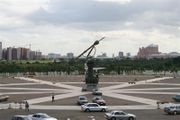
Abuja's Central District is located between the foot of Aso Rock and into the Three Arms Zone to the southern base of the ring road. It is like the city's spinal cord, dividing it into the northern sector with Maitama and Wuse, and the southern sector with Garki and Asokoro. While each district has its own clearly demarcated commercial and residential sectors, the Central District is the city's principal Business Zone, where practically all parastatals and multinational corporations have their offices located. An attractive area in the Central District is the region known as the Three Arms Zone, so called because it houses the administrative offices of the executive, legislative and judicial arms of the Federal Government. A few of the other sites worth seeing in the area are the Federal Secretariats alongside Shehu Shagari Way, Aso Hill, the Abuja Plant Nursery, Eagle Square (which has important historic significance,as it was in this grounds that the present democratic dispensation had its origin in May 29, 1999) and the Tomb of the Unknown Soldier across the road facing it. The National Mosque and National Church are located opposite each other on either side of Independence Avenue. A well known government office is the Ministry of Defence, popularly nicknamed "Ship House".
Garki District
The Garki District is the area in the southwest corner of the city, having the Central District to the north and the Asokoro District to the east. The District is subdivided into units called "Areas". Garki uses a distinctive naming convention of "Area" to refer to parts of Garki. These are designated as Areas 1 to 11. Garki II is used to differentiate the area from Garki Area 2. Visitors may at first find this system of names confusing. Garki is presently the principal business district of Abuja. Numerous buildings of interest are located in this area. Some of them include the General Post Office, Abuja International Conference Center located along the busy Herbert Maculay Way, Nicon Luxury Hotel (formally known as Abuja Sofitel Hotel and Le Meridian), Agura Hotel and Old Federal Secretariat Complex Buildings (Area 1). A new 5 star hotel, Hawthorn Suites Abuja is also located in Garki II. Area 2 is mainly used for residential purposes, although a zoological garden as well as Garki Shopping Center are located in Area 2. Several banks and other commercial offices are located along Moshood Abiola Way in Area 7. The Headquarters of the Nigerian Armed Forces, namely Army Headquarters, Airforce Headquarters and Navy Headquarters are all located in the Garki District. The tallest building in this district is the Radio House, which houses the Federal Ministry of Information and Communications, and the Federal Radio Corporation of Nigeria (FRCN). The Nigerian Television Authority (NTA) Stations and Corporate Headquarters are also based in Garki. The Federal Capital Development Authority (FCDA) which oversees and runs the Administration of the Federal Capital Territory has its offices in Garki. The Office of the Minister of the Federal Capital Territory, Abuja is located in Area 10. Other places of note include the Arts and Culture Center and The Nigerian Police Mobile Force Headquarters in Area 10. The Abuja Municipal Area Council, which is the local Government administration has its headquarters in Area 10. The new United States Embassy is also located in the Garki district.
Wuse District
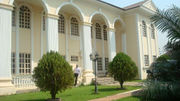
Wuse District is the northwestern part of the city, with the Maitama District to its north and the Central District to its south. The District is numbered Zones 1-8. The Wuse Market is Abuja's principal market (Zone 5). The second most important Post Office in the city is located here. This district also houses the Sheraton Hotel and Towers (Zone 4), Ibro International hotel, the Foreign Affairs Ministry Headquarters (Zone 1) and Nigerian Customs Services Headquarters, Corporate Affairs Commission (Zone 5), Federal Road Safety Commission (FRSC), National Agency For Food And Drugs Administration (NAFDAC) (Zone 7), Wuse General Hospital, and the Nigerian Tourism Development Corporation. Just as Garki District has Garki II, Wuse has Wuse II. This is distinct from Wuse Zone 2.
Maitama District
Maitama District is to the north of the city, with the Wuse and Central Districts lying to its southwest and southeast respectively. This area is home to the top bracket sections of society and business, and has the reputation of being very exclusive and very expensive. Interesting buildings include the Transcorp Hilton Hotel, National Communications Commission Headquarters (NCC), National Universities Commission (NUC), Soil Conservation Complex, and Independent National Electoral Commission (INEC). The British High Commission is located along Aguiyi Ironsi Way, in Maitama. Also, the Maitama District Hospital is another notable building in Maitama. Maitama District is home to many of the European embassies in Nigeria.
Asokoro District
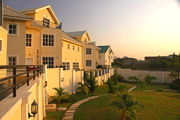
Asokoro District, the doyen of all the districts, houses all of the state's lodges/guest houses. The ECOWAS secretariat is a focal point of interest. Asokoro is located to the east of Garki district and south of Central district. It is one of the most exclusive districts of Abuja and houses virtually all of the federal cabinet ministers; in addition, the Presidential Palace (Aso Rock) is located in Asokoro district. By virtue of this fact, Asokoro is the most secured area of the city.
Gwarimpa District
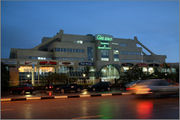
Gwarimpa is the last district located in the Abuja Municipal Area Council. It is a 20 kilometer driver from the central district area of the city and contains the largest single housing estate in Nigeria, called the Gwarimpa Housing Estate. The Estate was built by the Administration of General Sani Abacha and is the largest of its kind in Africa . It provides residence for the majority of the civil servants in Federal Ministries and government parastatals. The ECOWAS Court has an official quarters for the President and Members of the Court in Gwarimpa.
Weather and climate
The FCT experiences three weather conditions annually. This includes a warm, humid rainy season and a blistering dry season. In between the two seasons, there is a brief interlude of harmattan occasioned by the North East Trade Wind, with the main feature of dust haze, intensified coldness and dryness. The rainy season begins from April and ends in October, when daytime temperatures reach 28-30 degrees and nighttime lows hover around 22-23 degrees. In the dry season, daytime temperatures can soar as high as 40 degrees and nighttime temperatures can dip to 12 degrees, resulting in chilly evenings. Even the chilliest nights can be followed by daytime temperatures well above 30 degrees. The high altitudes and undulating terrain of the FCT act as moderating influence on the weather of the territory. Rainfall in the FCT reflects the territory's location on the windward side of the Jos Plateau and the zone of rising air masses. The annual total rainfall is in the range of 1100 mm to 1600 mm.
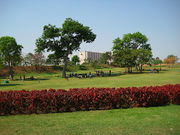
Vegetation
The area now designated the Federal Capital Territory falls within the Guinean forest-savanna mosaic zone of the West African sub-region. Patches of rain forest, however, occur in the Gwagwa plains, especially in the gullied train to the south and the rugged south-eastern parts of the territory. These areas of the FCT form one of the surviving occurrences of the mature forest vegetation in Nigeria.
Skyline
The Abuja skyline is made up of mostly mid-range and a few tall buildings. Only recently have tall buildings begun to appear on the skyline. Most of the buildings are modern in design, reflecting that it is a new and modern city. Plans have been made to build skyscrapers such as the Millennium Tower which is currently under construction. When finished, this structure will loom 170 meters above the city. The Tower will be part of a huge cultural development complex called the Nigeria National Complex including the Nigeria Cultural Centre, a 120.000 m2 structure dedicated to the art and culture of Nigeria. Both the Cultural Centre and the Millennium Tower have been designed by the Italian architect Manfredi Nicoletti.
|
Landmarks
- Millennium Tower (Abuja) U/C
- Central Bank of Nigeria headquarters
- Nigerian Presidential Complex
- Aso Rock, official residence of the President of Nigeria
- Zuma Rock
- NNPC towers
- Abuja International Conference Centre African Hall
- Central District
- Nigerian Communications Commission building
- Maitama District home of the embassies
- Millennium Park
- National Library
- Castle of Law
- National Mosque
- National Ecumenical Centre (National Church)
- Abuja Stadium
- The Velodrome
- Ecowas Secretariat
- Ladi Kwali Pottery Centre
Parks and open areas
Abuja is home to several parks and green areas with the largest one being Millennium Park. Millennium Park was designed by world renowned architect Manfredi Nicoletti and was officially opened by the United Kingdom's Queen Elizabeth II in December 2003.
Sister cities
![]() Brasília, Brazil
Brasília, Brazil ![]() Detroit, United States
Detroit, United States ![]() Kanpur, India
Kanpur, India
References
- ↑ "Explore Abuja City". Stay in Abuja dot com. http://www.stayinabuja.com/aboutfct.php?c=explore.
- ↑ 2.0 2.1 "Life of poverty in Abuja's wealth". news.bbc.co.uk. BBC News, Tuesday, 13 February 2007. 2007-02-13. http://news.bbc.co.uk/2/hi/africa/6355269.stm. Retrieved 2007-08-10.
- ↑ "World Bank Conference: African Regional Roundtable on Upgrading Low-income Settlements". www.citiesalliance.org. World Bank, 3–5 October 2000, Johannesburg, South Africa, p. 16. http://www.citiesalliance.org/cdsdb.nsf/Attachments/South+Africa+roundtable/$File/African+Regional+Roundtable+on+Upgrading+Oct00.pdf. Retrieved 2007-08-10.
- ↑ "Resettlement Issues, Squatter Settlements and the Problems of Land Administration in Abuja, Nigeria’s Federal Capital". fig.net. 5th FIG Regional Conference Accra, Ghana, 8–11 March 2006. http://www.fig.net/pub/accra/papers/ts18/ts18_01_jibril.pdf. Retrieved 2007-08-10.
- ↑ Polgreen, Lydia (13 December 2006). "In a Dream City, a Nightmare for the Common Man". nyt.com (New York Times, 13 December 2006). http://www.nytimes.com/2006/12/13/world/africa/13abuja.html?ex=1323666000&en=9b1bb2ecd684791c&ei=5090&partner=rssuserland&emc=rss. Retrieved 2007-08-10.
External links
- Official site of Nigeria's Federal Capital Territory (FCT) and City of Abuja
- Abuja.Net
- Abujacity.com
|
||||||||||||||||||||||||||||||||||||||
